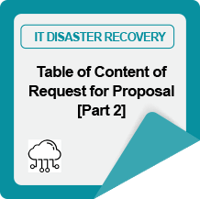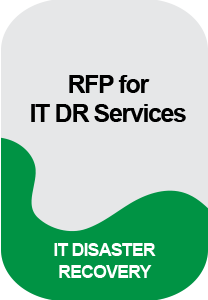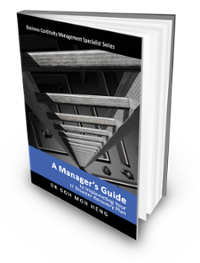Request-for-Proposal (RFP)

Provision of good background information on the history of DR activities in your organization will be very useful when you are setting up a RFP process.
 The rationale for your request of an RFP and your organization’s IT roadmap or vision that have a bearing on the scope of RFP will help the vendor design a more suitable solution for your organization. Click Part 1 icon to go back to Part 1]
The rationale for your request of an RFP and your organization’s IT roadmap or vision that have a bearing on the scope of RFP will help the vendor design a more suitable solution for your organization. Click Part 1 icon to go back to Part 1]
These are some of the information needed. The key areas are:
Part 1 |
Part 2 |
|
|
Evaluation of RFP
The baseline for carrying out a successful RFP evaluation is the evaluation criteria that determine the effectiveness with which you can compare and evaluate all the proposals received.
There are many ways to implement the evaluation criteria:
- Match the compliance statement directly between the RFP requirements statements with all Vendors’ proposals. Next, compare across all the mandatory requirements with those Vendors who can comply fully and those with alternatives, and drill into further details if required to determine the most suitable Vendor.
- Establish a scoring system for each section of your For example, it can be based on a weighted system that relates to the degree of importance, and you assign to each of the sections being considered; including your level of comfort on the vendor’s response to each of your requirements.
In the following sections, we will look into details of mandatory portions that you have to be satisfied with, before being able to accept the vendor’s proposal and recommend to the management for approval.
Legal Requirements
Check and confirm that all mandatory legal requirements are accepted by the vendors. If there are deviations, you have to decide whether they are acceptable and present minimum risks to your organization.
At the same time, also, ensure the compliance and level of liquidity damages, if any, are sufficient to address the level of commitment to the vendor in delivering the plan.
Business and Technical Requirements
Ensure all proposed hardware, software and network equipment are similar to that you have requested in the RFP. If not, provide equivalent functions and capacity that can meet expected RTO and RPO requirements to address your business needs.
The DR delivery methodology is important and critical to ensuring the DR scope and objectives can be met. Thus, thoroughly check and confirm the details of how the vendor intends to manage and deliver the expected services using this methodology.
Qualification
For any DR Planning project, the experience of the Organization DR Coordinator from the vendor is the key driving force towards successful delivery of the project; likewise, the technical expertise. To be able to react to unforeseen circumstances, ensure replacements are available in a short time. This is to minimize the impact, and delays to the delivery schedules.
You have to examine the qualifications of each that the vendor is going to deploy to deliver your project. If any of the individuals are unacceptable, immediately inform the vendor and request for a replacement.
Although checking the references provided by the Vendors are very useful for your verification of the Vendor’s performance and capability. You must bear in mind that the Vendors will not give a customer’s reference that will give adverse views on their organization and services. So, you must also check with your peers or network to find out the quality of the Vendors.
Anyway, we would like to provide some key questions that you may want to verify with the references provided by the Vendor or through your personal or business contacts.
- Were they satisfied with the work done by the Vendor?
- Was it completed on time and within budget?
- Was the staff provided competent and experienced?
- Did the vendor have enough backup and competent resources to serve as replacement staff?
- Was there any significant scope creep during the engagement?
- Was the vendor responsive to satisfying their needs?
Cost
Apart from ensuring the proposed cost is reasonable and acceptable according to your RFP’s requirements, check carefully to ensure there are no hidden costs. Once you have established that the cost is final, make it clear to the vendor that this is the final cost mutually agreed on and any associated costs not discussed will be absorbed by the vendor.
Some of the basic costs to consider during the evaluation process include:
- One time engagement cost for establishing the DR Plan, setting up the structure, and verifying the workability of the backup sites and equipment
- Operational costs: the monthly subscription cost of the backup sites and equipment
- Testing costs: the cost of conducting DR test
- DR activation costs: the cost of declaring disaster
- Tape handling costs: the cost of collecting and sending backup tapes to the offsite storage
- Any facility extension costs: the cost of using the backup site for extending the usage if permitted by the vendor
- Any other cost for conducting awareness programs, briefing, revising of DR Plan, and so on
RFP Award
After negotiating and agreeing with all the scope, schedule, items, deliverables and pricing of the proposal with the most suitable Vendor, carry out the formal contract award with the Vendor upon your management’s approval.
However, before you sign on the dotted line, be careful that all the following documentations are included in the full contract document:
- Updated mutually agreed on RFP document
- Vendor’s proposal document
- Communication exchanges document such as emails, faxes, letters, and minutes of meeting
- Presentation materials
- Benchmarking documentation (if any)
- Any other supplements
More Information About IT DR Blended LearningTo know more about our blended learning program and when the next course is scheduled, feel free to contact our friendly course consultant colleagues via sales.ap@bcm-institute.org. They are the BL-DR-3 Blended Learning DR-300 IT Disaster Recovery Implementer and the BL-DR-5 Blended Learning DR-5000 IT Disaster Recovery Expert Implementer. |
||
 |
 |
|
 |
 |
|
 |
Please feel free to send us a note if you have any of these questions to sales.ap@bcm-institute.org |
![FAQ [BL-DR] [5] DRP-5000](https://no-cache.hubspot.com/cta/default/3893111/e1e30273-3d46-4a5b-9f9d-11d9457a377a.png) |







